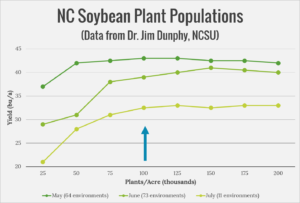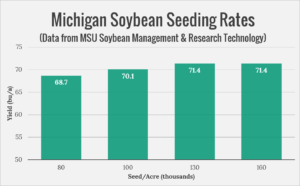As we gear up for #plant17, now is the time to start thinking about planting management decisions. At this point, most of you have selected varieties and purchased seed, so one of the next things to think about is soybean seeding rate. Conventional wisdom says planting high populations will ensure maximum yields, but actually, this is not always the case.
Seed is one of the most expensive inputs for soybean growers, so it’s essential to plant the right amount of seed to minimize input costs while still maintaining high yields, ultimately increasing profitability. Numerous seeding rate studies carried out across the U.S. suggest that the optimal plant population for maximum return on investment is 80,000 to 120,000 plants per acre. We’ll take a deeper look at some of this research below.
First, is work carried out by Dr. Dunphy right here in North Carolina evaluating a wide range of plant populations. In the graph below, notice that this is very little yield difference (especially for the earlier planting dates) in the treatments after you pass 100,000 plants per acre, suggesting there is no value in planting higher populations.
If we look work from other states, we see similar trends. In data from Nebraska’s On-Farm research program, we see only a 1 bushel/acre difference in the yield of treatments seeded with 90,000 seed/acre and treatments seeded with 180,000 seed/acre.
And looking at data from Michigan’s On-Farm research trials we see similar trends. There was a 2.7 bushel/acre increase in the yield of the 160,000 thousand seed/acre treatment compared to the 80,000 seed/acre treatment. Also, notice that there was no difference between the 130,000 and 160,00 treatments.
This research demonstrates that soybean plants have the unique ability to adapt and the plants can compensate for a wide range of planting populations. The yield per acre remains relatively constant across planting rates, likely because the seeds produced per plant is inversely related to the number of plants per acre.
So, is a 2 or 3 bushel per acre increase in yield, worth the extra cost of seed? Well, assuming a seed cost of $60 a bag (that’s approximately $0.40 per thousand seed) we can calculate the cost of seed for these populations.
To pay for the cost of going from 100,000 seed/acre to 200,000 you would need to increase yield by 4.3 bu/acre (assuming $10 soybeans). Based on the data collected in North Carolina and across the U.S., we would not expect this may not be a profitable decision.
If your target is 100,000 plants/acre, remember to account for percent germination and for the fact that not every seed that germinates becomes a viable plant. Planting 120,000 seed per acre, should easily result in 100,000 plants/acre in typical conditions. But, a number of factors can influence ideal seeding rate. Higher rates are recommended for the following:
- Very early planting
- Late planting (after June 1)
- Low productivity soils
- Planting with a drill
I know many of you are not comfortable going down to 100,000 plants per acre, and I’m not suggesting you all do that, as you know your fields best. But I would challenge you to try a seeding rate a little lower than you typically use. This is an easy way to save money in tight economic times without sacrificing significant (if any) yield.
References:
Dunphy, E.J. 2014. NCSU Soybean Production Class.
Staton, M. and Seamon, M. 2017. SMaRT 2016 On-Far Research Report. http://fieldcrop.msu.edu/uploads/files/2016_SMaRT_Research_Report_Final.pdf.
University of Nebraska. 2017. On-Farm Research 2016 Growing Season Results. http://cropwatch.unl.edu/OnFarmResearch/2016OnFarmResearchResults.pdf.











